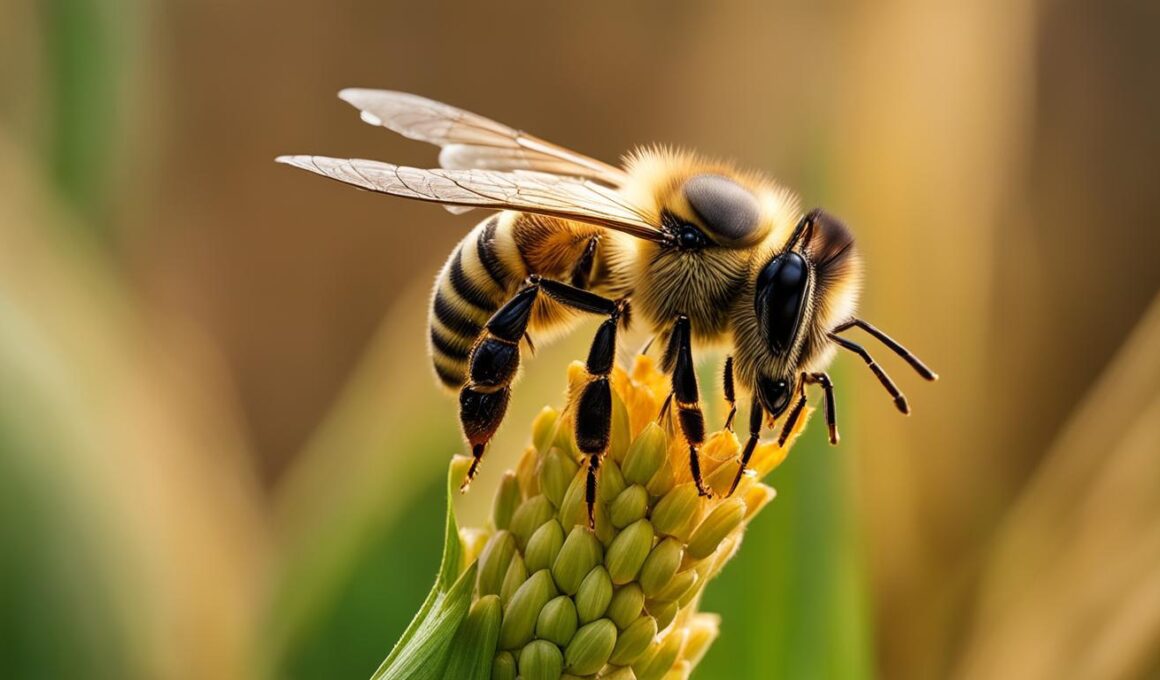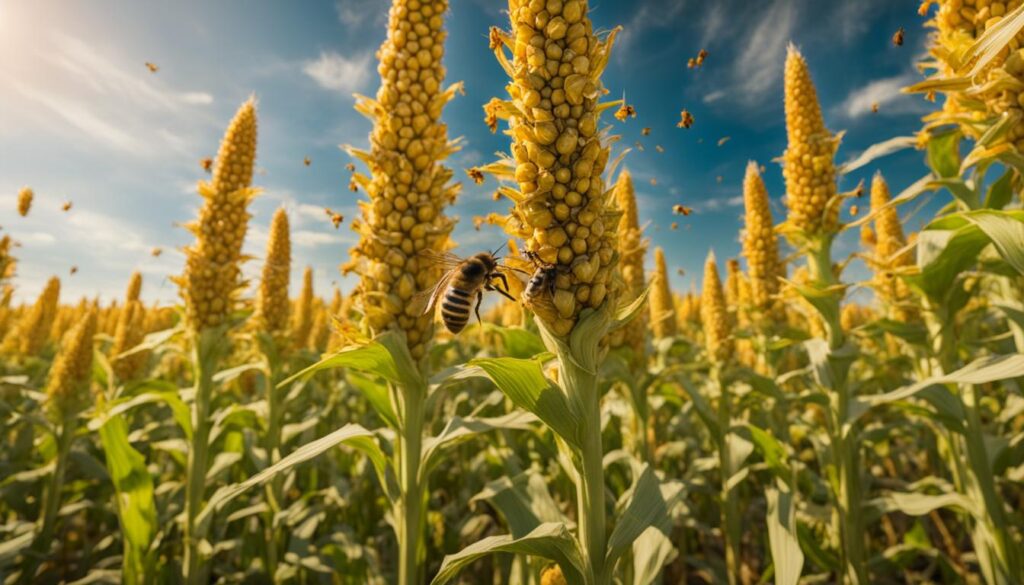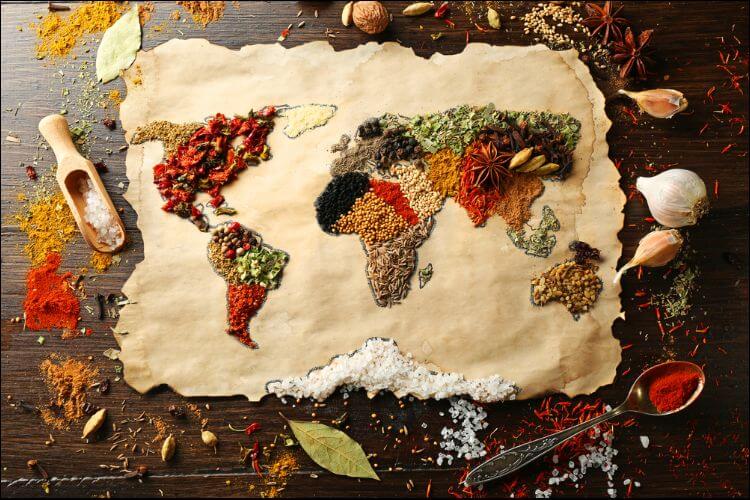Corn pollination is a crucial process that relies heavily on honey bees. Understanding the importance of pollination and the role of honey bees in this process is essential for recognizing the agricultural benefits and crop value they bring.
Post Summary:
- Honey bees play a vital role in pollinating corn and contributing to agricultural success.
- The value of honey bee pollination to crops, including corn, is estimated to be 10-20 times higher than honey and beeswax production combined.
- Without honey bees, corn yields and quality would decrease, leading to food shortages and increased prices.
- Honey bees are efficient pollinators due to their social nature and large colony sizes.
- Beekeepers play a crucial role in providing pollinating hives for corn crops.
The Role of Bees in Pollination
Pollination is a vital process for crop reproduction, and bees are among the most important pollinators. While there are various types of bees, including solitary bees and bumblebees, honey bees are particularly efficient pollinators due to their social nature and large colony sizes. Honey bee colonies contain one queen and tens of thousands of worker bees, allowing for the efficient pollination of crops. While many wild bees are solitary and visit specific kinds of plants, honey bees are versatile and will visit any flowers that provide sufficient nectar and pollen. This makes honey bees an ideal choice for crop pollination, including corn.
“Bees have a unique relationship with flowers. They collect nectar and pollen from flowers as a food source for themselves and their offspring. However, in the process, they inadvertently transfer pollen from the male parts of a flower to the female parts, enabling fertilization and the production of seeds. This cross-pollination is essential for the reproduction of many crops, including corn. Without the help of bees, crops would struggle to produce fruits and seeds, leading to reduced yields and crop failures.”
As highly efficient pollinators, honey bees play a critical role in sustaining agricultural productivity and food security. Their ability to visit a wide variety of flowers and their social organization make them valuable contributors to crop pollination. Understanding the role of bees in pollination is crucial for appreciating the significance of these small creatures in our agricultural systems and the broader ecosystem.
The Importance of Bee Diversity
While honey bees are excellent pollinators, it is important to recognize the value of other bee species in pollination as well. Solitary bees and bumblebees, for instance, have different foraging behaviors and preferences, allowing them to pollinate specific crops more effectively. Promoting biodiversity and habitat conservation is essential for maintaining a healthy and diverse bee population, ensuring the resilience and productivity of our crops.
| Bee Species | Main Foraging Behavior | Pollination Benefits |
|---|---|---|
| Honey Bees | Generalist foragers | Efficient pollinators for a wide range of crops |
| Solitary Bees | Specialized foragers | Effective pollinators for specific crops, such as tomatoes and blueberries |
| Bumblebees | Strong and efficient foragers | Excellent pollinators for crops like tomatoes and strawberries |
Beekeeping for Pollination
Beekeepers play a crucial role in providing pollinating hives for crops like corn. The success of pollination depends on the strength and size of the hive. A good pollinating hive should have at least one deep brood chamber full of bees, brood, and eggs, indicating a healthy and productive colony.
Beekeepers often move hives after sunset or early in the morning to avoid disrupting foraging bees. The timing of the hive move is important to ensure that bees are introduced to the crop during the flowering period for effective pollination. Beekeepers and growers should consider having a formal pollination contract to ensure proper communication and bee management throughout the pollination period.
Hive Management and Hive Size
Hive management is essential for maintaining strong and productive colonies. Regular inspections and monitoring for diseases and pests, such as Varroa mites, can help ensure the health and vitality of the bees. Additionally, providing sufficient food sources, such as nectar and pollen, is crucial for colony growth and survival.
| Hive Size | Number of Bees | Brood Chamber |
|---|---|---|
| Small Hive (5 frames) | Up to 10,000 bees | One brood box |
| Medium Hive (10 frames) | 10,000 – 30,000 bees | One or two brood boxes |
| Large Hive (20 frames) | Over 40,000 bees | Two or more brood boxes |
“The strength and size of the hive are key factors in successful pollination. Healthy colonies with a sufficient number of bees can efficiently pollinate crops, like corn, resulting in improved yields and quality.”
Managing hives for pollination also involves providing suitable hive locations, free from excess shade or harsh winds, and ensuring access to diverse sources of nectar and pollen. Beekeepers can work closely with farmers to plan hive placements and optimize pollination efforts.
Note: The image above illustrates the importance of pollinating hives in crop pollination.
Protecting Bees from Pesticides
Pesticides pose a significant threat to honey bees and other pollinators, with potential negative impacts on their health and survival. It is crucial to understand pesticide toxicity and exposure to develop effective strategies for protecting pollinators and promoting sustainable agriculture practices.
The Impact of Pesticide Toxicity
Pesticides can have varying levels of toxicity to bees, with some being highly toxic and others having minimal effects. The toxicity of a pesticide depends on factors such as the chemical composition, application method, and dosage. Exposure to toxic pesticides can lead to bee mortality, reduced foraging activity, impaired navigation, decreased immune function, and reproductive issues. It is essential to minimize bee exposure to highly toxic pesticides to protect their populations and ensure effective pollination.
Pesticide Residues in Bee Products
Pesticide residues can be found in bee products such as honey, pollen, and beeswax. Bees can carry pesticide residues back to the hive when they forage on flowers treated with pesticides. These residues can accumulate over time and potentially contaminate the bee colony’s stored resources. Regular monitoring of pesticide residues in bee products is necessary to ensure the safety of these products for human consumption and to assess the level of pesticide exposure experienced by honey bees.
Best Management Practices
Implementing best management practices can help protect pollinators from pesticide exposure and promote their overall health and well-being. Here are some recommended practices:
- Read and follow pesticide labels carefully to ensure proper application and minimize risks to pollinators.
- Adopt integrated pest management (IPM) principles to reduce the need for pesticide use and promote the use of alternative pest control methods.
- Choose the least toxic pesticide options available when necessary.
- Request untreated seeds when possible to avoid the use of pesticide-coated seeds.
By adopting these practices, farmers, beekeepers, and policymakers can take active steps to protect pollinators and create a safer environment for honey bees and other beneficial insects.
| Pesticide | Toxicity Level |
|---|---|
| Insecticide X | Highly Toxic |
| Insecticide Y | Moderately Toxic |
| Insecticide Z | Low Toxicity |
Conclusion
The decline of honey bees is a matter of great concern, considering their crucial role in pollinating crops like corn. It is imperative to prioritize conservation efforts to protect these invaluable pollinators and ensure sustainable agriculture.
Honey bees face various threats, including diseases, parasites, habitat loss, and pesticide exposure. These factors contribute to their decline, which ultimately puts global food production at risk. By implementing conservation measures, such as protecting natural habitats and raising awareness about the importance of pollinators, we can mitigate the challenges faced by honey bees.
Promoting sustainable agriculture practices is essential in safeguarding honey bees and the crops they pollinate. Sustainable farming methods minimize the use of pesticides and prioritize ecosystem health. By adopting these practices, we can create a healthier environment for honey bees and support their vital role in our food supply.
To secure the future of honey bees and ensure the availability of crops like corn for future generations, it is critical that we take collective action. By investing in pollinator conservation, we can protect honey bees from decline and preserve the intricate balance of our ecosystems.
FAQ
What is the value of honey bee pollination to agricultural crops?
According to the USDA, the value of honey bee pollination to agricultural crops is estimated to be between 10 and 20 times the combined value of honey and beeswax production.
How much does honey bee pollination contribute to the value of corn?
Pollination by honey bees is estimated to contribute approximately $15 billion in added crop value to corn.
Why are honey bees efficient pollinators for crops like corn?
Honey bees are efficient pollinators due to their social nature and large colony sizes. They visit any flowers that provide sufficient nectar and pollen, making them ideal for crop pollination.
What should be considered when moving hives for corn pollination?
Hive moves should be done after sunset or early in the morning to avoid disrupting foraging bees. The timing of the move is important to ensure effective pollination during the flowering period of the crop.
How can bees be protected from pesticides?
Best management practices include reading and following pesticide labels, practicing integrated pest management principles, using the least toxic options, and requesting untreated seeds when possible.
Why is the conservation of honey bees important for our food supply?
Honey bees and other pollinators play a crucial role in ensuring the success and sustainability of our food supply. Their decline would have severe implications for global food production.










